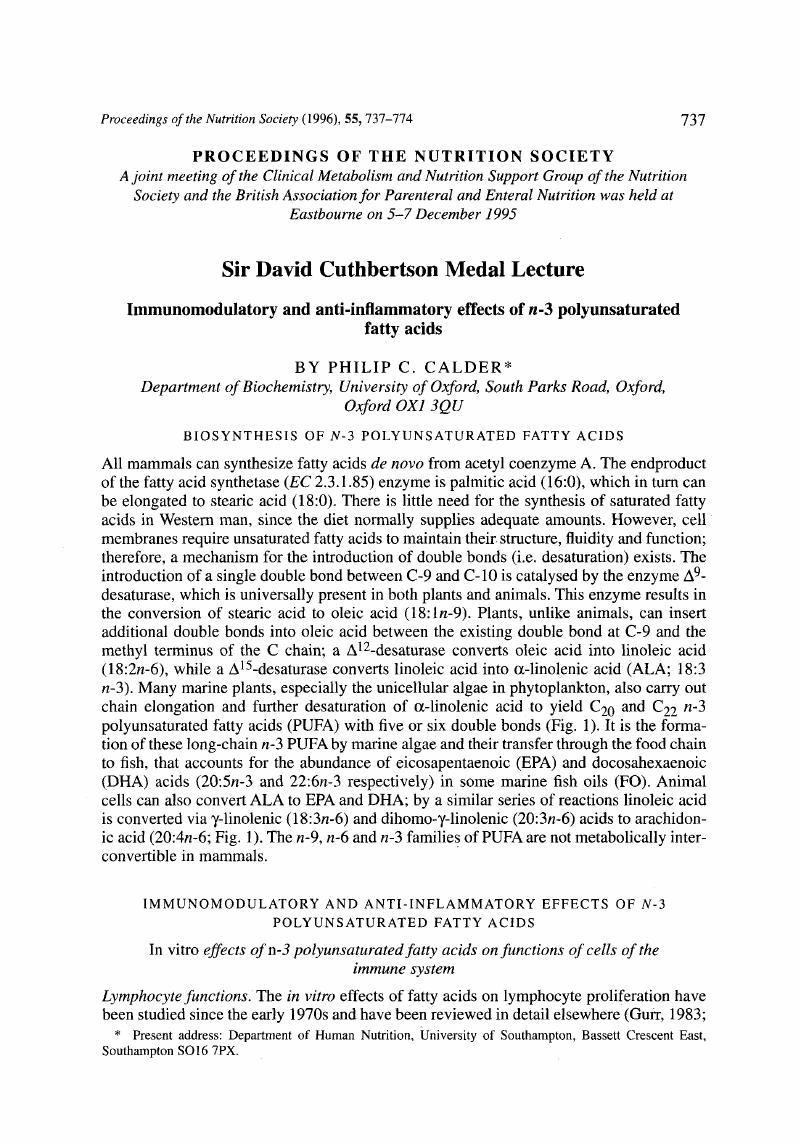Crossref Citations
This article has been cited by the following publications. This list is generated based on data provided by Crossref.
Jeffery, Nicola M
Sanderson, Peter
Newsholme, Eric A
and
Calder, Philip C
1997.
Effects of varying the type of saturated fatty acid in the rat diet upon serum lipid levels and spleen lymphocyte functions.
Biochimica et Biophysica Acta (BBA) - Lipids and Lipid Metabolism,
Vol. 1345,
Issue. 3,
p.
223.
Whitehouse, M. W.
Macrides, T. A.
Kalafatis, N.
Betts, W. H.
Haynes, D. R.
and
Broadbent, J.
1997.
Anti-inflammatory activity of a lipid fraction (lyprinol) from the NZ green-lipped mussel.
InflammoPharmacology,
Vol. 5,
Issue. 3,
p.
237.
Jeffery, Nicola M.
Cortina, Mario
Newsholme, Eric A.
and
Calder, Philip C.
1997.
Effects of variations in the proportions of saturated, monounsaturated and polyunsaturated fatty acids in the rat diet on spleen lymphocyte functions.
British Journal of Nutrition,
Vol. 77,
Issue. 5,
p.
805.
Sanderson, Peter
and
Calder, Philip C.
1998.
Dietary fish oil appears to prevent the activation of phospholipase C-γ in lymphocytes.
Biochimica et Biophysica Acta (BBA) - Lipids and Lipid Metabolism,
Vol. 1392,
Issue. 2-3,
p.
300.
Miyasaka, C.K.
Souza, A.A.
de Melo, M.Pires
Curi, C.Pithon
Lajolo, F.M.
and
Curi, R.
1998.
Fish Oil Given by Gavage Increases Lymphocyte Proliferation and Production of Hydrogen Peroxide by Rat Macrophages.
General Pharmacology: The Vascular System,
Vol. 31,
Issue. 1,
p.
37.
Calder, Philip C.
1998.
Medicinal Fatty Acids in Inflammation.
p.
1.
Calder, Philip C
1998.
Fat chance of immunomodulation.
Immunology Today,
Vol. 19,
Issue. 6,
p.
244.
Calder, Philip
and
Deckelbaum, Richard
1998.
Current Opinion in Clinical Nutrition & Metabolic Care,
Vol. 1,
Issue. 2,
p.
139.
Khalfoun, B
Sibué, D
Bardos, P
and
Lebranchu, Y
1998.
Docosahexaenoic and eicosapentaenoic acids inhibit the CD28-lymphocyte activation pathway in vitro.
Transplantation Proceedings,
Vol. 30,
Issue. 8,
p.
3978.
Miles, Elizabeth A.
and
Calder, Philip C.
1998.
Modulation of immune function by dietary fatty acids.
Proceedings of the Nutrition Society,
Vol. 57,
Issue. 02,
p.
277.
Calder, Philip C.
1998.
Dietary fatty acids and lymphocyte functions.
Proceedings of the Nutrition Society,
Vol. 57,
Issue. 4,
p.
487.
Fernandes, Gabriel
1998.
Medicinal Fatty Acids in Inflammation.
p.
73.
Hornstra, G.
Barth, C. A.
Galli, C.
Mensink, R. P.
Mutanen, M.
Riemersma, R. A.
Roberfroid, M.
Salminen, K.
Vansant, G.
and
Verschuren, P. M.
1998.
Functional food science and the cardiovascular system.
British Journal of Nutrition,
Vol. 80,
Issue. S1,
p.
S113.
Harbige, Laurence S.
1998.
Dietaryn-6 andn-3 fatty acids in immunity and autoimmune disease.
Proceedings of the Nutrition Society,
Vol. 57,
Issue. 4,
p.
555.
Peterson, L. D.
Jeffery, N. M.
Thies, F.
Sanderson, P.
Newsholme, E. A.
and
Calder, P. C.
1998.
Eicosapentaenoic and docosahexaenoic acids alter rat spleen leukocyte fatty acid composition and prostaglandin E2production but have different effects on lymphocyte functions and cell‐mediated immunity.
Lipids,
Vol. 33,
Issue. 2,
p.
171.
Wu, Dayong
and
Meydani, Simin Nikbin
1998.
n-3 Polyunsaturated fatty acids and immune function.
Proceedings of the Nutrition Society,
Vol. 57,
Issue. 4,
p.
503.
Miyasaka, C.K
de Souza, J.A.Alves
Torres, R.P
Filho, J.Mancini
Lajolo, F.M
and
Curi, R
1998.
Effect of the Administration of Fish Oil by Gavage on Activities of Antioxidant Enzymes of Rat Lymphoid Organs.
General Pharmacology: The Vascular System,
Vol. 30,
Issue. 5,
p.
759.
Fernandes, Gabriel
Troyer, Dean A.
and
Jolly, Christopher A.
1998.
The effects of dietary lipids on gene expression and apoptosis.
Proceedings of the Nutrition Society,
Vol. 57,
Issue. 4,
p.
543.
Barber, Matthew D.
Ross, James A.
and
Fearon, Kenneth C. H.
1998.
The anti-cachectic effect of fatty acids.
Proceedings of the Nutrition Society,
Vol. 57,
Issue. 4,
p.
571.
Kelly, F. D.
Mann, N. J.
Turner, A. H.
and
Sinclair, A. J.
1999.
Stearic acid‐rich diets do not increase thrombotic risk factors in healthy males.
Lipids,
Vol. 34,
Issue. S1Part2,





